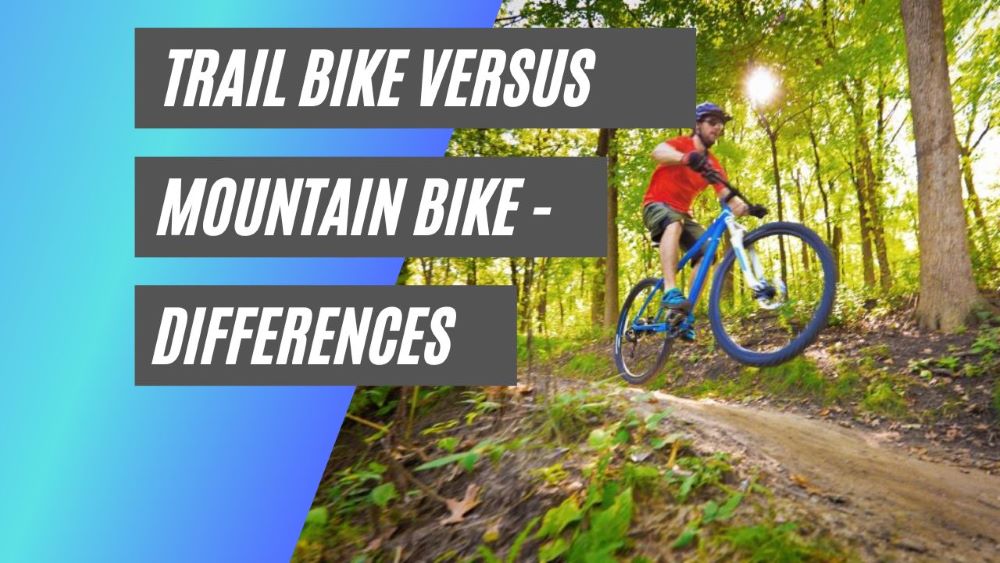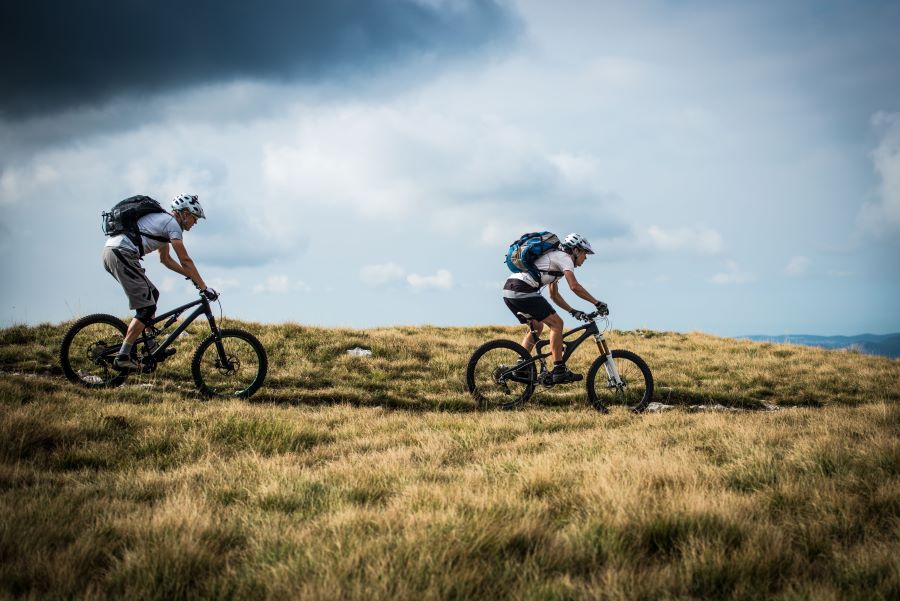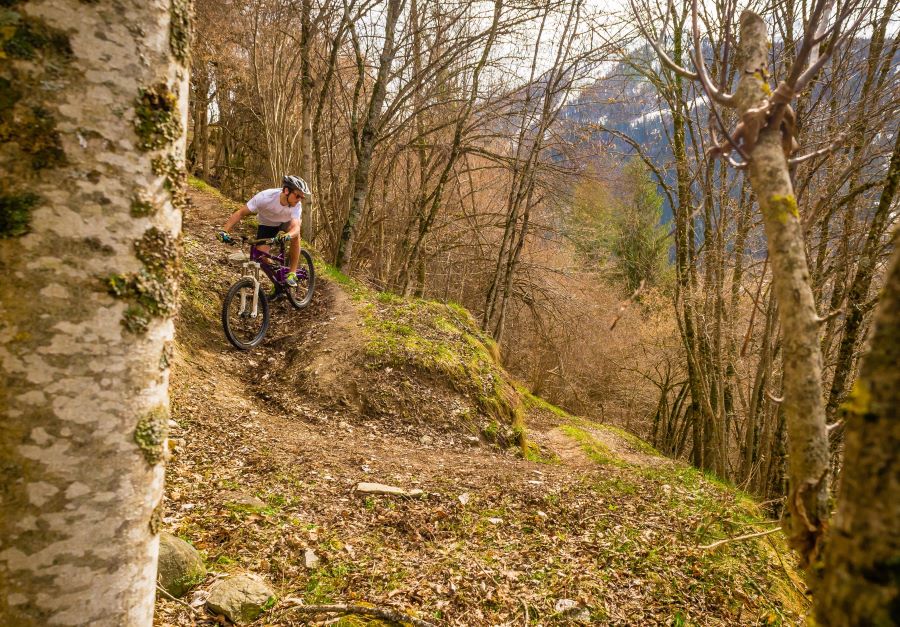This post may contain affiliate links. If you click an affiliate link and make a purchase, I may earn a commission. Also, as an Amazon Associate, I earn from qualifying purchases.--
Trail bikes offer many of the abilities of different mountain bikes all in one package.
If you want to trail both mild and technical terrains and confidently go uphill as well as downhill, a trail bike is an ideal option.
In this post, I’ll take a look at all the features that you get with trail bikes, and also at the features you get with the three main types of mountain bikes (CX, downhill and enduro). Then I’ll take a good look at the differences between trail and mountain bikes (and I’ve managed to whittle it down to the main seven).

Trail Bikes Vs Mountain Bikes – Features
Let’s first look at the three main types of mountain bikes, and the different features that they have (before moving on to trail bikes):
Types of Mountain Bikes And Their Features
The demand for mountain bikes has grown rapidly (Source) but not every buyer wants to use their bike for the same purpose on an identical landscape.
To cater to all kinds of audiences, mountain bikes have evolved to serve very specific purposes.
While there are niche styles of mountain bikes for a small clientele such as a fat bike for snowy or sandy conditions or a DJ pump for dirty jumps or pump trucks, the majority of mountain bikes can be classified into the following 3 types.
1. Cross Country (XC) Bike
The perfect bike for anyone whose idea of thrill revolves around speed and long distances; cross-country bikes are all about endurance, efficiency, and pedaling performance.
Their low weight optimizes them for going fast, uphill, and around racetracks, which is usually flatter landscapes such as forest or woodland paths, fire roads, smooth or paved roads, or a single track (trail of a bike’s width running through the woods).
Their geometry, like that of road bikes, is geared around climbing hills seamlessly and getting around a racecourse.
It does not offer similar comfort when it comes to driving down steep slopes, which is why cross-country bikes do not cater to mountainous and technical trails. Therefore, XC bikes are for those who value speed and distance over the adrenaline of tricky terrains.
Marathon/Endurance bikes are a similar (but unique) type of mountain bike that offers similar uphill and speed performance with a little bit more emphasis on a comfortable descent (thus, more accessible trails) and long-distance marathon endurance.

2. Downhill Bike
Think of downhill bikes as the exact opposite of cross-country bikes. They purely revolve around going downhill and the steep terrain, huge drops, and bumpy jumps that come with it.
For experienced mountain bikers who want to tackle the most challenging terrains, a downhill bike is the best investment.
However, they only offer a unidirectional experience. Pedaling up a hill or trail is not a possibility and other means such as a chairlift, hiking, or shuttle road need to be arranged.
The adventure associated with descending a slope is dependent on the availability of such means.
3. All-Mountain/Big Mountain or Enduro Bike
Although All-Mountain/Big Mountain and Enduro bikes are two distinct types of bikes, their uses are quite similar.
Like downhill bikes, they are both manufactured for efficient descent on the roughest trails around, but both also ensure the ability to reach the top with a little effort and pedaling power.
These bikes are a valuable purchase for those who largely dabble in downhill trails but would also like the ability to pedal back up before the next ride begins.
The difference between the two is that Enduro bikes lean more towards downhill bikes, designed to descend as fast as possible with more effort going uphill than All-Mountain bikes, making them optimal for races rather than recreational use.
Trail Bikes
Now that the three other categories of mountain bikes are clear, it is time for the bike of the hour – a trail bike.
Where is that used?
As mentioned earlier, a trail bike is an all-rounder that sits exactly between the comfortable climbing position of XC bikes and a confident descent on aggressive and technical landscapes of downhill bikes, as opposed to All Mountain and Enduro bikes that leaned more towards the downhill type of mountain bikes.
While not suitable for racing in a particular type (speed or descent) of event, trail bikes are adaptable to all kinds of terrain, be it mild or rough: forest paths, bumpy jumps, adequately sized rocks, dips, rough roads, and cross-country trails.
It is the best purchase for anyone who wants a bit of all kinds of riding in all sorts of terrain (I belong to this category!) or are unsure of what they are looking for.
Resultantly, the baseline difference between trail bikes and other mountain bikes is the landscape and direction in which they are used.
All other structural differences exist to allow for this major distinction of purpose to be possible.
Differences Between Trail Bikes and Other Mountain Bikes
Since each kind of mountain bike is built with a certain kind of use and terrain in mind, their components will be chosen and arranged differently.
These distinctions illustrate how unique trail bikes are from other kinds of mountain bikes.
Difference 1 – Front Suspensions
The higher the pedaling efficiency required, the shorter the suspension travels.
As a result, cross-country bikes have a maximum of 4 inches (100mm) long suspension travel to ease a rapid uphill climb, translate more power from the pedals to the ground, and maintain a low weight.
Since enduro and downhill bikes both rely more on gravity than pedaling power, they have longer front suspension travels ranging from 140 to 180mm and 180 to 200mm respectively.
The length of front suspensions in trail bikes lies between these two extremes. Extending up to 130mm and mostly made up of air springs, its longer length (than XC bikes) offers comfort and easier control over obstacles.
Since length comes with weight, they are heavier than the suspension forks of XC bikes (lighter than that of enduro) but that is acceptable because this heavy-duty enables them to withstand the stress of aggressive terrain, and trail bikes are not known for their light weight.
Many trail bikes now also contain a lockout in their front suspension forks to control the suspension travel according to the landscape.
Difference 2 – Rear Suspensions
The pattern of length in rear suspensions is similar to that of the front ones.
The length itself may vary, such as the rear suspensions of downhill bikes are longer than the front ones (180mm to 250mm) while those of trail bikes lie between 120mm and 160mm.
What’s unique is that many XC bikes are hardtails i.e., they lack a rear suspension on account of low weight, improved feedback on the terrain being traveled, and higher pedaling efficiency.
This is one reason why XC mountain bikes are not suitable for rough landscapes.
Difference 3 – Head Tube Angle
The length of suspensions has a direct effect on the angle of the head tube.
Since XC bikes have the shortest suspension travels, they contain a narrow/steeper head angle (between 69 and 71 degrees) which improves how the bike can be handled but makes them twitchy when descending downhill.
On the contrary, trail bikes possess slack and wider head angles that are optimal for downhill riding.
Having a slack head tube angle (between 65 and 68 degrees) pushes the front wheel ahead of the handlebars, making the two tires further apart from each other and enhancing the wheelbase.
This increases the stability of a bike when navigating steep descents, although making it tough to properly weigh the front wheel during turns.
As expected, downhill bikes are even slacker with a head tube angle below 65 degrees, establishing a very low center of gravity that translates into higher confidence on steep landscapes.
Difference 4 – Tires
The tires of a trail bike can be either sized 27.5 inches or 29 inches, with a width of around 3 inches.
These wide tires are heavily threaded and are knobbier so that they have a better grip on slippery rocks and unstable surfaces.
This can be compared to the narrower (2.2 inches wide) tires of a cross-country mountain bike that largely use the 29-inch size.
They are smoother, with minimal threads and knobs, to minimize the rolling resistance. These tires are specially designed for high speeds, which is not the case with trail bikes.
Enduro bikes use similar sizes as trail bikes, although they have the option of having a 29-inch tire in the front and a 27.5 one in the rear.
Given their predominance towards downhill bikes which require higher grip, their knobs are also more aggressive for better traction. They often have 2-ply (double-thick) casings for durability.
Difference 5 – Brake Rotors
Since trail bikes offer fast descents down a steep slope, of which a large chunk of the speed is fueled by gravity, they require and thus possess a larger (between 140 and 160mm) and more powerful braking system than cross-country bikes.
Their larger size also reduces the likelihood of overheating and brake failure.
While the brake rotors are even larger in an enduro and downhill bike, it is not as enhanced in cross-country bikes.
Given their twitchy nature on a downhill ride as is (due to the head tube angle and other factors), a strong braking system will only exacerbate the situation.
Difference 6 – Handlebars
The rougher the terrain to be navigated, the wider the handlebar to offer the leverage to steer aggressive terrain. (Source)
The wide handlebar offers more control and stability, minimizing the chances of losing balance and toppling to an injury.
Consequently, enduro and downhill bikes have the widest handlebars, cross-country bikes have them narrow, and trail bikes house intermediate-sized handles.
The narrow handlebars of an XC bike are designed for maximum speed, made possible by the rider getting a feel of what the front wheel is doing through the narrow handlebar. It allows rapid steering around sharp corners.
Difference 7 – Frame
Cross-country bikes are reliant on their light weight, which is why they are primarily made up of carbon fiber (high-quality models) or aluminum (cheaper options), both of which also offer high strength.
Additionally, their stem length is high (between 90 and 100mm) so that the posture of the rider pushes them ahead, improving the traction on flat ground and increasing acceleration.
As opposed to this, trail bikes do not require low weight.
Durability and affordability hold higher importance, which is why steel tubing is the preferred material of the frame.
Their stem length is also lower (between 40 and 80mm) than that of XC bikes, allowing the rider to hold a more relaxed and backward posture for higher stability during rapid descents.

Is a Trail Bike Better Than Other Mountain Bikes?
Trail bikes cannot be compared to other mountain bikes on a general basis. Each kind of mountain bike holds their merits in the kind of purpose they serve.
Trail bikes are not better than other mountain bikes if you want to go at a high speed on flat terrains or uphill (a cross-country bike is) or tackle the steepest and most challenging terrain (an enduro or downhill bike might be more up your alley).
However, if you are looking for the most versatile option, then a trail bike could be for you. They are adept at going both up and downhill, and can also take on a range of terrain.
If you’re the kind of rider that takes on many different challenges, then a trail bike could be exactly what you need.
